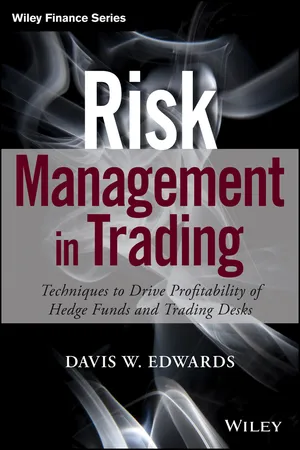
Risk Management in Trading
Techniques to Drive Profitability of Hedge Funds and Trading Desks
Davis Edwards
- English
- ePUB (disponibile sull'app)
- Disponibile su iOS e Android
Risk Management in Trading
Techniques to Drive Profitability of Hedge Funds and Trading Desks
Davis Edwards
Informazioni sul libro
A comprehensive resource for understanding how to minimize risk and increase profits
In this accessible resource, Wall Street trader and quantitative analyst Davis W. Edwards offers a definitive guide for nonprofessionals which describes the techniques and strategies seasoned traders use when making decisions. Risk Management in Trading includes an introduction to hedge fund and proprietary trading desks and offers an in-depth exploration on the topic of risk avoidance and acceptance. Throughout the book Edwards explores the finer points of financial risk management, shows how to decipher the jargon of professional risk-managers, and reveals how non-quantitative managers avoid risk management pitfalls.
Avoiding risk is a strategic decision and the author shows how to adopt a consistent framework for risk that compares one type of risk to another. Edwards also stresses the fact that any trading decision that isn't based on the goal of maximizing profits is a decision that should be strongly scrutinized. He also explains that being familiar with all the details of a transaction is vital for making the right investment decision.
- Offers a comprehensive resource for understanding financial risk management
- Includes an overview of the techniques and tools professionals use to control risk
- Shows how to transfer risk to maximize results
- Written by Davis W. Edwards, a senior manager in Deloitte's Energy Derivatives Pricing Center
Risk Management in Trading gives investors a hands-on guide to the strategies and techniques professionals rely on to minimize risk and maximize profits.
Domande frequenti
Informazioni
CHAPTER 1
Trading and Hedge Funds
OVERVIEW OF BOOK
- Backtesting and Trade Forensics. Backtesting is a disciplined approach to testing trading ideas before making bets with actual money. Trade forensics is a post-mortem analysis that identifies how well a trade is tracking pre-trade predictions and if markets have changed since the trade was initiated.
- Calculating Profits and Losses. Once a trade has been made, traders have to calculate the daily profits and losses. For some financial instruments, this is as simple as checking the last traded price from an exchange feed. For other investments, calculating the fair value of the trade is challenging.
- Setting Position Limits. The size of investments that traders can make are typically limited by the volatility of their expected daily profits and losses. In other words, risk can be a way to measure size. As a result, the goal of hedge fund traders is to maximize the profits relative to a fixed amount of risk.
- Hedging. Hedging is a trading strategy designed to limit profits and losses in one investment by taking an offsetting position in another asset. For example, a hedge fund might want to lock in profits associated with a physical asset like an oil well that they can’t sell right away. They can agree to sell oil at a fixed price and remove the risk of price fluctuations.
- Managing Option Risk. Certain types of financial instruments, particularly options, present much more complicated risk management challenges for traders. Risk managers have developed a variety of techniques to model this risk and fit options risk with other position limits.
- Managing Credit Risk. Trading can’t be done in isolation. Every time someone wants to buy an asset, someone else needs to sell. Not all trades settle right away—trading often involves obligations that are taken on in the future. As a result, traders depend on their trading partners meeting their trading obligations, and are exposed to the risk that their trading partners will default on their obligations.
TRADING DESKS
- Mutual Funds. Mutual funds are a pooled-investment fund where the leadership of the fund manages investments on behalf of investors. These funds are restricted from many investment strategies deemed too speculative or risky for uninformed investors.
- Proprietary Trading Desks. A trading desk found in many investment banks that operates like an internal hedge fund to invest the firm’s capital.
- Hedge Funds. Hedge funds are pooled investment funds similar to mutual funds. They differ in that they do not cater to the general public—only to accredited investors. Many hedge funds seek to profit in all kinds of markets by using leverage (in other words, borrowing to increase investment exposure as well as risk), short-selling, and using other speculative investment practices that mutual funds are restricted from using.